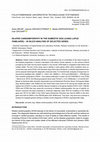Papers by Joanna Gruszczyńska

Acta Scientiarum Polonorum, May 15, 2023
Retinal degenerations are a series of genetically inherited diseases resulting in significant vis... more Retinal degenerations are a series of genetically inherited diseases resulting in significant visual impairment and blindness. Among domestic cat breeds, there are degenerations of different courses associated with mutations in CEP290, CRX, AIPL1 and KIF3B genes. The aim of this study was to design diagnostic tests to identify the mutated alleles. The primers for PCR and restriction enzymes for PCR-RFLP were designed to detect mutations in genes. Mutation in the nucleotide sequence encoding AIPL1 protein causes a change in the protein structure, where a monomer is formed instead of a homodimer. Interactions of CEP290, CRX, AIPL1 and KIF3B proteins with other proteins that play a role in the proper functioning of the retina were observed. The occurring interactions between some of these proteins suggest a possible link between diseases caused by mutations of genes encoding these proteins. In other animal species, co-expression of the analyzed genes with other genes affecting retinal functions was noted.

Folia Pomeranae Universitatis Technologiae Stetinensis Agricultura, Alimentaria, Piscaria et Zootechnica
Cystinuria is an inherited genetic disease associated with mutations in the SLC3A1 and SLC7A9 gen... more Cystinuria is an inherited genetic disease associated with mutations in the SLC3A1 and SLC7A9 genes. The results of studies in cats indicate heterogeneity of the disease. So far 1 mutation in the SLC3A1 gene and 5 mutations in the SLC7A9 gene have been discovered. Cystinuria is often detected too late (later in life), when adults have already had offspring. Quick and easy diagnosis of the disease is therefore important, even before the symptoms appear. The aim of this study was to design simple diagnostic tests to detect 6 mutations that can cause feline cystinuria. Bioinformatic analysis of the linkage of SLC3A1 and SLC7A9 with other proteins was performed and attempts were made to evaluate the structural and functional changes that occur due to mutations. The following programs and databases were used in the bioinformatics analysis: Ensembl, NCBI, Primer-BLAST, NEBcutter, STRING, SWISS-MODEL, Variant Effect Predictor (VEP). The proposed primers and enzymes for PCR-RFLP and AS-PCR ...
Utilization of the selected microsatellite sequences in optimizing the mating plan in an experime... more Utilization of the selected microsatellite sequences in optimizing the mating plan in an experimental fl ock of Ayam Cemani breed. The parental fl ock initially included 2 cocks and 9 hens, that originated from different breeding farms, and then the following F 1 generation included 42 birds (15 hens and 27 cocks). The experimental fl ock of Ayam Cemani breed was bred at the Poultry Farm of the University of Life Sciences in Wilanów-Obory. Owing to the specifi c character of the experiment, the following microsatellite sequences were selected based on literature data: MCW0145, MCW0184, MCW0210, LEI0071, and ADL0306, all being linked with the body weight of hens (
Animal science papers and reports
Acta Scientiarum Polonorum Zootechnica, 2022
Morphological changes of the vertebrae, whether congenital or acquired, are more and more frequen... more Morphological changes of the vertebrae, whether congenital or acquired, are more and more frequent causes of movement difficulties of both humans and other species of mammals. The most frequently diagnosed pathologies of the spine include: degenerative changes, congenital defects, inflammatory diseases, and proliferative changes. This article presents the characteristics of selected morphological changes in the spine, the reasons for their occurrence, and the diagnosis. Some of abnormalities have a genetic basis, sometimes already known, such as in the case of vertebral deformity syndrome in domestic cattle, which is caused by a mutation in the SLC35A3 gene. At other times, the genetic factor is only speculated as in the case of human scoliosis - some studies indicate its autosomal dominant nature of inheritance.
Head of an English Bulldog with a bilateral cleft palate in three-dimensional VR shown from diffe... more Head of an English Bulldog with a bilateral cleft palate in three-dimensional VR shown from different angles. (MP4 243 kb)

G en BRCA1 został sklonowany w 1994 r, przez Miki i jego zespół (1). Gen ten znajduje się w długi... more G en BRCA1 został sklonowany w 1994 r, przez Miki i jego zespół (1). Gen ten znajduje się w długim ramieniu chromosomu 17 (17q21). Jest to duży gen obejmujący 80kpz DNA (2) i kodujący białko, składające się z 1863 aminokwasów (3). BRCA1 jest genem supresorowym, kontrolującym cykl komórkowy poprzez takie mechanizmy, jak apoptoza i naprawa DNA. Jego rolą jest utrzymanie stałości genomu (3). Gen ten jest aktywatorem transkrypcji, stanowi element systemu naprawczego dwuniciowych pęknięć w DNA, a także uczestniczy w remodelowaniu chromatyny w kompleksie SWI/SNF (4). BRCA1 zawiera dwa typy domen białkowych: palec RING przy N-końcu i dwie domeny BRCT na C-końcu (5). Domena RING wiąże białko BARD1, które w reakcji z białkiem BRCA1 znosi mutacje w obrębie domeny RING BRCA1. Przypuszcza się, że to kompleks BRCA1-BARD1 ma największy wpływ na proces nowotworzenia (4). Rocznie około 12 tys. Polek choruje na raka piersi. Przyjmuje się, że w 30% przypadków przyczyną choroby są predyspozycje genetyczne, związane z mutacjami w genach BRCA1 i BRCA2. U nosicielek mutacji w genie BRCA1 ryzyko zachorowania na raka piersi wynosi od 50 do 80%, a raka jajnika około 40%. Nowotwory u tych osób pojawiają się zazwyczaj przed 50 rokiem życia. W badaniach funkcji genu BRCA1 jako zwierzęta laboratoryjne wykorzystano myszy, szczury, świnie domowe, psy i kury. Jednak podstawowym zwierzęcym modelem doświadczalnym była mysz, ze względu na łatwość hodowli, a także znajomość genomu tego zwierzęcia (6). Gen Brca1 u myszy znajduje się w chromosomie 11, koduje białko składające się z 1812 aminokwasów. Z badaniami prowadzonymi na myszach wiązano duże nadzieje, gdyż stwierdzono w 58% podobieństwo między białkiem BRCA1 myszy i człowieka (7). Gen Brca1 u tych gryzoni pełni bardzo ważną rolę podczas wczesnej embriogenezy, ma wpływ na rozwój listków zarodkowych i struktur nerwowych, a także na proliferację komórek (8). Konwencjonalne modele myszy Jednym z pierwszych modeli, wyprowadzonych w celu badania genu Brca1, był

Folia Pomeranae Universitatis Technologiae Stetinensis Agricultura, Alimentaria, Piscaria et Zootechnica
Dilated cardiomyopathy (DCM) is a progressive loss of contractility of the heart muscle as the di... more Dilated cardiomyopathy (DCM) is a progressive loss of contractility of the heart muscle as the disease progresses. It causes a decrease in the heart’s minute capacity, i.e. the volume of blood pumped by the heart into the blood vessels in one minute. DCM leads to congestive heart failure and sudden death. The aim of this study was to identify in silico genes within which mutations have occurred that may cause DCM in the domestic dog (Canis lupus familiaris), to identify dog breeds at risk, and to propose breed-specific diagnostic molecular tests. For bioinformatic analyses of sequences retrieved from GenBank (NC_006587.3 – FGGY, NC_006583.3 – DCC and CM023383.1 – PDE3B) and from scientific publications (PDK4 – from patent publication number US 2011/0307965 A1 and STRN – Meurs et al. 2010), the following programs were used: Primer3 v. 0.4.0, NEBcutter v. 2.0 and BLAST. Based on literature data, domestic dog breeds such as Doberman Pinscher, Boxer, Portuguese Water Dog, Newfoundland, ...
Cleft palate is one of the most common congenital defects in the domestic dog associated with abn... more Cleft palate is one of the most common congenital defects in the domestic dog associated with abnormal craniofacial development. Brachycephalic breeds seem to be most predilected. This anatomical and functional disorder is characterized by the presence of the fissure connecting the oral and nasal cavities. There are clefts of primary and/or secondary palate. Despite developing diagnostic and therapeutic me- thods, clinical examination and surgery are still the basis for the diagnosis and possible treatment of the malformation. In most cases euthanasia of the animal is performed. The eliminatin of affected individuals from the breeding is strongly recommended. The defect has probably a heterogeneous etiology, both genetic and environmental factors contributing to its formation. However, its genetic etiology has not yet been clearly explained.

The aim of the study was to identify C295G mutation in T gene in the Polish population of Polish ... more The aim of the study was to identify C295G mutation in T gene in the Polish population of Polish Lowland Sheepdog and to analyze the consequences of matchmaking the carriers of the mentioned mutation of T gene conditioning shortened tail and tailessness. The samples were collected from 61 Polish Lowland Sheepdogs. Polymerase chain reaction was performed using the same primers such Indrebø et al. [6] had used. To identify mutations in exon 1 C295G T gene, there was used BstEII restriction enzyme which cuts the sequence with a length of 702 bp at nucleotide position 191. The mutation created an additional restriction site at position 160. Among the 61 tested dogs there were 18 recessive homozygotes and 43 heterozygotes identified. There was no dominant homozygote, because, as the authors of other studies indicate, mutation of the gene C295G T is lethal in that system and causes embryos’ mortality at an early stage of embryonic development. We observed decreasing litter size with short...
Journal of applied genetics, 2002
Our study aimed at comparative analysis of microsatellite polymorphism in locus OMHC1 (MHC Class ... more Our study aimed at comparative analysis of microsatellite polymorphism in locus OMHC1 (MHC Class I) in Polish Heath Sheep and Polish Lowland Sheep (Zelazna variety). The study was conducted on 100 ewes of each breed. We identified 13 alleles of the gene in Polish Heath Sheep and 9 in Polish Lowland Sheep. We found marked differences in frequency of OMHC1 alleles between both breeds. The heterozygosity coefficient and PIC, amounting to 0.79 and 0.77 for Polish Heath Sheep, and 0.82 and 0.80 for Polish Lowland Sheep, respectively, suggest considerable variability in both breeds. Additionally, the values of both coefficients indicate that OMHC1 locus can be used as a genetic marker.

Ivermectin is a drug used to fight endoand exoparasites in animals at regular base in veterinary ... more Ivermectin is a drug used to fight endoand exoparasites in animals at regular base in veterinary practice. Basically this substance is safe for mammals. The mechanism of its action is based on dysfunction of nerve impulses conduction. P-glycoprotein is a membrane transport protein present in endothelial cells of lungs, kidneys, liver and pancreas. It prevents toxin penetration into the brain neurons and many other organs outside central nervous system including barriers: blood–testis, blood–placenta, blood–urine. This protein is coded by Multi Drug Resistance gene 1 (MDR1 gene) and is located in membranes of blood-brain barrier cells. When a mutation in MDR1 gene appears the protein isn’t able to function properly. In that case ivermectin goes to canine central nervous system cells and induces neurotoxic clinical signs, that is why early diagnostic is very important especially to prevent poisoning. The reasons and effects of the mutation as well as elements of molecular diagnostic t...
Journal of applied genetics, 2005
Exon 2 of the Ovar-DR gene is known to encode the MHC outer domain (alpha or beta chain) that for... more Exon 2 of the Ovar-DR gene is known to encode the MHC outer domain (alpha or beta chain) that forms the binding area to antigens presented. The study was aimed at analysing exon 2 Ovar -DRB1 gene polymorphism in Polish Heath Sheep and Polish Lowland Sheep (Zelazna variety). A total of 101 and 99 ewes of the respective breeds were included in this study. We identified 65 different haplotypes in Polish Heath Sheep and 68 in Polish Lowland Sheep. The PCR-RFLP method and PCR products sequencing made it possible to identify two new sequences of exon 2 Ovar-DRB1 gene (AY230000 and AY248695). A distinct polymorphism in the exon 2 sequence presents possibilities for immune response toward a great variety of pathogens.

Acta Scientiarum Polonorum Zootechnica
Canine Degenerative Myelopathy (CDM) is an incurable, chronic, slow progressive, autoimmune disea... more Canine Degenerative Myelopathy (CDM) is an incurable, chronic, slow progressive, autoimmune disease of the canine spinal cord affecting older dogs, medium to large breeds. Etiopathogenesis is still unknown but the latest data show that mutation of superoxide dismutase 1 gene (SOD1) is known to cause amyotrophic lateral sclerosis (ALS) in humans. That is why CDM is a canine model of ALS. The initial clinical sings of spinal cord dysfunction (ataxia, spastic paresis, paraplegia) are commonly mistaken with other common problems (hip dysplasia or intervertebral disc disease). The antemortem diagnosis requires exclusion of them all but definitive confirmation of CDM requires pathologic examination of spinal cord tissue. There is no treatment available but novel therapies are promising. The DNA test is a commercially available tool to help breeders avoid producing CDM "at risk" offspring what significantly reduces the frequency of mutated alleles in future generations.

Udder diseases (mastitis) are a serious cause of economic losses in sheep breeding as they have a... more Udder diseases (mastitis) are a serious cause of economic losses in sheep breeding as they have a negative impact on lamb rearing and the quality of dairy products. So far the progress in treatment and prevention of these diseases has been insufficient, giving ground for searching possibilities of using natural immunity to combat mastitis. The aim of the study was to assess the relationship between the microsatellite polymorphism of selected Ovar-MHC genes and the health status of the mammary gland of sheep. The research was carried out on sheep of the Polish Heath and Polish Lowland breeds. In ovine milk the number of somatic cells (SCC) and the percentage of the lymphocyte subpopulation were assessed. On the basis of genomic DNA, molecular analysis of the Ovar-MHC gene fragments (OLADRB1, OLADRB2, OMHC1) polymorphism was performed. Significant differences were found in SCC and the percentage of lymphocytes (CD4, CD8, CD19) in the milk depending on the alleles of the Ovar-MHC genes...

TURKISH JOURNAL OF VETERINARY AND ANIMAL SCIENCES
Introduction Embryo development, traits of chicks (hatching weight and chick quality), and hatcha... more Introduction Embryo development, traits of chicks (hatching weight and chick quality), and hatchability are associated with the hatching egg weight (1-5). Differences observed in these traits also depend on the line's genetic background (6). Regardless of the line and direction of conducted selection, it may affect egg production, egg parameters, embryonic development, and chick parameters of different avian species (7-11). Previous reports showed that strong relationships between egg weight and 1-dayold chick weight were observed in quails (12) and broiler chickens (13). Chickens with the highest body weight hatched from heaviest eggs (4,5). Although selection for body weight has a positive effect on egg weight increase, it may contribute to reduction in different reproduction traits, such as egg production, fertility, and hatchability (11,14,15). Japanese quail is a poultry species commercially bred for meat (in countries of West Europe, such as Spain and France) and eggs (in Japan and other East Asian countries) and also used for experimental purposes (16). Japanese quail can be used in selection experiments as an avian model especially because of their high reproductive potential, fast growth rate, food conversion ability, and early sex maturity, and also the generation interval period is short (16,17). Regardless of the purpose of reproduction, issues related to the rate of embryonic development can be of great importance, especially











Uploads
Papers by Joanna Gruszczyńska